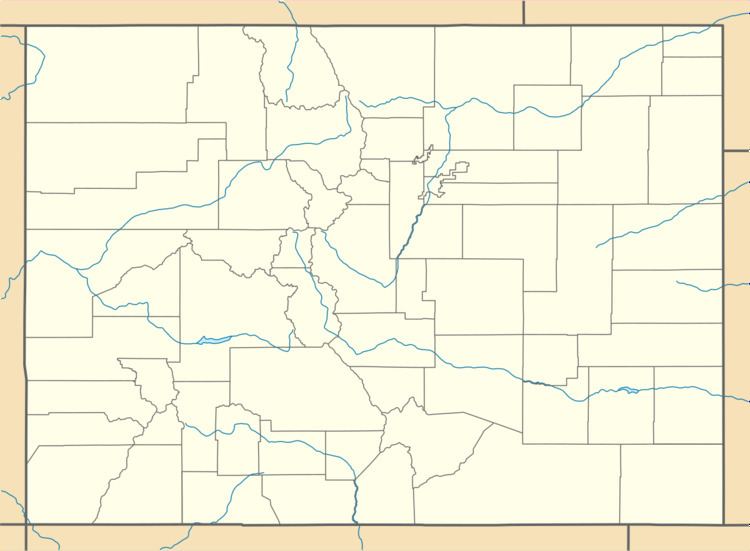 | ||
Silver mining in Colorado has taken place since the 1860s. In the past, Colorado called itself the Silver state. (Nevada also calls itself the Silver state. Idaho, however, actually produces the most silver in the US.)
Contents
Central City-Idaho Springs district
Silver veins were discovered in the Central City-Idaho Springs district a short time after gold was discovered there in 1859. However, mining the silver veins was delayed for the most part until smelters were built in the late 1860s. The veins of the district are zoned in a roughly concentric manner, with gold-bearing pyrite veins in the center, and silver-bearing galena veins more common in the outlying areas.
Montezuma district
The first silver discovery in Colorado was a mile south of Montezuma in 1864. The discovery led to others in the Montezuma district, including those at Saints John.
Argentine district
The discovery of silver in the Montezuma district led to the silver discovery at the Belmont lode in the Argentine district just northeast of the Montezuma district.
Georgetown-Silver Plume district
Prospectors found gold veins near present Georgetown in 1859. Silver, the main product from the district, was not discovered until 1864.
Leadville district
See Leadville mining district
Despite the early silver discoveries, Colorado’s largest silver district, Leadville, was not discovered until 1874. Leadville was the largest silver-producing district in Colorado. Cumulative production through 1963 was 240 million troy ounces of silver, 3 million troy ounces of gold, 987 million metric tons of lead, 712 million metric tons of zinc, and 48 million metric tons of copper.
Aspen district
In 1879, prospectors searching for another Leadville were led to the Aspen area by geological maps that showed outcrops of Leadville Limestone. They found silver ore on Aspen Mountain, but ore production was small until the Denver and Rio Grande Railroad reached the town in 1887 and provided economic shipment of ore to smelters. Ore occurs in the Mississippian Leadville Limestone and the lower part of the overlying Pennsylvanian Belden Formation. Ore minerals include galena, sphalerite, and native silver. Early production was almost all silver, but after 1900, lead and zinc became economically important. Major mining operations continued until 1952. Total production was 101 million troy ounces of silver, 294 tons of lead, and 11,000 tons of zinc.
Gilman district
Silver was discovered in the Gilman mining district in 1878 or 1879. As the deeper sulfide ores were reached, the miners found that the ore contained so much zinc that the smelters refused to buy it. A roaster and magnetic separator were installed in 1905 to separate out the zinc minerals, turning the problem into an asset. The mining operations transitioned increasingly to zinc, although the Eagle Mine was still the leading producer of silver in the state in 1930. The New Jersey Zinc Company entered Gilman in 1912, and over a period of years purchased all the principal mines and the entire townsite. Zinc was the economic mainstay until 1931, when low zinc prices forced the company to switch to mining copper-silver ores. Production of the district through 1964 was 64 million troy ounces (1,990 metric tons) of silver, 348,000 ounces (10.82 metric tons) of gold, 578,000 metric tons of zinc, 114,000 metric tons of lead, and 92,000 metric tons of copper. Zinc production resumed in 1941, and remained the principal product of the mines until they were closed in the 1980s.
Creede district
The Creede district in Mineral County was discovered in 1887, but did not become a significant silver producer until 1891. The ore occurs as veins along north-south trending faults, and as replacement bodies in the Creede Formation, a Tertiary ash-flow tuff. Ore minerals are sphalerite, galena, acanthite, native silver, pyrite and chalcopyrite. Production through 1983 totaled 80 million ounces (2,490 metric tons) of silver, 150 thousand ounces (4.7 metric tons) of gold, and considerable lead and zinc.
Current production
The largest current source of silver in Colorado is as a byproduct of gold mining at the Cripple Creek & Victor Gold Mine, a large open-pit heap leach operation owned by Newmont Mining Corporation at Victor, Colorado (see Cripple Creek mining district). In 2006, the mine produced 4.0 metric tons (130,000 ounces) of silver.
